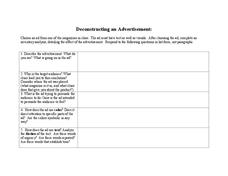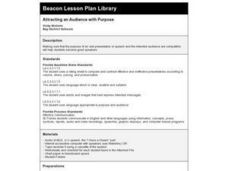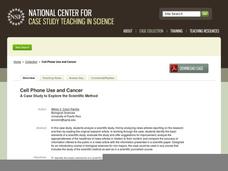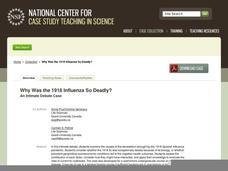Franklin D. Roosevelt Presidential Library & Museum
Pearl Harbor Activity #4: Who is the Audience?
Young historians use the prompts on a worksheet to analyze President Roosevelt's "Day of Infamy" speech. They identify the intended audience for the speech, the devices FDR used to persuade his audience, the responses promoted, and the...
Edmond Public Schools
SOAPSTone
Break an article down with a SOAPSTone chart. Class members determine the speaker, occasion, audience, purpose, subject, and tone. The chart includes a question for each of these elements, provides some clarifying text for each, and...
Virginia Department of Education
Identifying Audience and Purpose
Use a fun and creative activity to introduce junior high learners to how writing changes for different audiences and purposes. The activity begins with a reading by the instructor where teens visualize a food fight in the cafeteria. In...
Curated OER
Deconstructing an Advertisement
Bring in a stack of magazines and distribute this advertisement analysis worksheet to your emerging analysts. As your class members ponder an ad, they answer a series of questions to help them perform a complete analysis. They consider...
Have Fun Teaching
Identifying Author's Purpose
The multi-lesson, 47-page packet contains everything you need to ensure kids can recognize the clues provided to identify the type of text, the intended audience, and the author's purpose in writing the passage.
K20 LEARN
Argument Is Everywhere: Introduction to Argument
C.E.R = Claim + Evidence + Reasoning. That's the framework behind building a solid piece of argument writing. Introduce young writers to this format with an engaging lesson that uses YouTube videos and a PowerPoint to illustrate the...
Curated OER
Writing a Friendly Letter
Elementary schoolers write a friendly letter. In this letter writing lesson interrogative and declarative sentences in their friendly letter. The students write to an intended audience.
Buck Institute for Edcuation
Presentation Plan
Behind a successful presentation is a solid plan. Whether class groups are involved in project-based learning or individuals are crafting a personal presentation, ask participants to identify their subject, the intended audience,...
Roy Rosenzweig Center for History and New Media
Patriots or Traitors - Point of View in the War for Independence
Patriots or traitors? Class members analyze images that present widely differing views of the Boston Tea Party, identifying the point of view of the image, the propaganda devices used, and the intended audience.
American Evolution
Virginia Runaway Slave Ads
What does an ad reveal about a culture, or about the values of its intended audience? Class members examine a series of runaway slave ads—one of which was written by Thomas Jefferson—and consider what these primary source documents...
Curated OER
Thumbs Up For Movie Reviews
If your class loves movies, this instructional activity is sure to interest them. After discussing the purpose and structure of movie reviews, young writers compose a movie review and discuss why people may read a review before they go...
Virginia Department of Education
Determining Purpose and Audience
Build the writing skills of your junior high wordsmiths with activities that introduce many essential skills of writing. As a class, they develop working definitions of formal vs. informal writing, explore different categories of...
National Council for the Social Studies
Analyzing a Product or Political Advertisement
How do advertisements evoke specific thoughts and feelings? Class members find out through the exploration of the Internet, videos, television, magazines, radio, and posters. Learners investigate commercial advertisements, political...
Curated OER
Editorial Writing
Use your class's knowledge of pollution and water treatment to write an editorial to town citizens. They apply prior knowledge in order to compose a letter intended for newspaper publication, focusing on writing to an appropriate audience.
Curated OER
An Honest Cigarette Ad?
Students recognize the intended audience for a certain advertisement They recognize advertising techniques aimed at the intended audience and create their own advertisements about the truth of cigarette smoking. Students begin to see...
Curated OER
Campaign Songs as Propaganda:Free Trade vs. Protectionism - In Whose Interest?
Young scholars analyze campaign messages about tariffs in a 19th-century campaign song. They read and discuss the lyrics, complete an analysis worksheet, and identify the intended audience of the song's message.
Curated OER
Tobacco
Young scholars write paragraphs about the message of an advertisement ad they see in magazines and their intended audience. In this advertisements lesson plan, students look at tobacco, clothing, hair products, and more.
Amani Project
Harmony Break! Finding Emotions With Music
Gather the entire family (or class members) for a fun Harmony Break! A volunteer thinks of a color from their Mood Meter that they will express by singing, playing an instrument, or performing a dance. After the performance, the audience...
Curated OER
Audience Influence
Students examine the media product and decide who the intended audience is. they invent a new audience profile and discuss ways the media image might be changed to suit this new audience. They may consider the language, images, sourcs or...
Curated OER
The Shakespeare Crowd
Students study the life and times of Shakespeare. They read and analyze one of his plays and use the Internet and videos to gain an understanding of how Shakespeare engaged his audiences, then and still today.
Curated OER
Attracting an Audience With Purpose
Learners discuss the attributes of a good speech and a bad speech, and listen to Martin Luther King Jr.'s speech, I Have A Dream. They rewrite a speech, directing it to a different audience than it was intended for.
National Center for Case Study Teaching in Science
Cell Phone Use and Cancer
The cell phone you're using is making you deaf: news at 11:00. Oftentimes, the media uses fear tactics and other techniques to increase its audience base. In an intriguing look at the difference between scientific journals and...
Curated OER
SOAPS Primary Source "Think" Sheet
Planning on using primary source materials? Introduce your class members to SOAPS, a worksheet that models how to analyze and reflect on primary source materials. Readers name the document, identify the subject (S), the occasion (O),...
National Center for Case Study Teaching in Science
Why Was the 1918 Influenza So Deadly?
Which factor was more influential in the 1918 flu epidemic: biology, or social and political conditions? Your AP biology class will research and debate one of these positions in an interesting and challenging instructional activity....

























